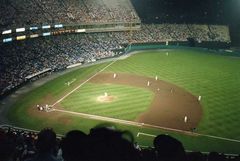Baltimore, Maryland: The Port City of Strength and Dignity

Baltimore is a city that has its roots from the beginning of our country’s development. The unique port location gave Baltimore the advantages of being the largest port near the sea in the Mid-Atlantic U.S. While this may have spring boarded the port city into a thriving community, it also brought a multilayer of culture which has contributed to the metropolitan city of today. Baltimore loves their sports and have proudly been the home of many playoffs and winning teams. Baseball scoreboards are the hot topic, but the stadiums for football and soccer have also become more popular venues for the fans.
Baltimore was originally named after an Irish dignitary, Lord Baltimore, who was a founding father of the area. The inhabitants were English and Irish and many of the areas names became a combination of Irish Gaelic. As a port, the first growth was due to Baltimore’s ability to thrive as a granary for the growing sugar cane market. During the War of 1812, the Battle of Baltimore brought famed lawyer Francis Scott Key to the area, where he penned the Star Spangle Banner, destined to become the national anthem of the U.S…
Pride of city created an environment where residents erected monuments dedicated to their history. Baltimore became known as The Monumental City and brought visitors from across the country to see their unique skyscape, churches and marvel at the history that was preserved.
While Baltimore was not part of the Confederate sympathizers, they experienced problematic riots during a Union march in the city. When the railroad offered increased prosperity, it soon took a turn during the 1873 Depression and during the 1877 workers strike when they were threatened with the lowering of their wages. It wasn’t until the 1907 fire that leveled seventy of the downtown area blocks, that Baltimore faced its most daunting survival.
The harbor was and still is today, the saving grace of Baltimore. Rebuilding and construction of this port city was slow at first, but the community eventually returned. Many of the areas, however, were not revitalized and it wasn’t until the 1970’s that focus turned to reclaiming some of the history of Baltimore through a renaissance effort. By the 1990’s, Baltimore could proudly proclaim over two hundred eighty locations as part of the National Register of Historic Places.
As the city grew, so did their interest in the arts and culture. Theatre, drama and schools for the arts blossomed as Baltimore became a metropolitan arts center. Notable universities and colleges, renowned around the world are located in Baltimore and the growth of both private and public schools has given Baltimore an elevation of status for higher learning institutions.
One thing that people notice when they visit Baltimore is that you can tell the local residents from the tourists by their unique dialect. Their tendency to drop the ‘t’s’ in their words have often been called “Baltimorese”. A speculation for their dialect is that Baltimore had its history in the working class, which carried through their history. Another way that you can differentiate the locals is their intensity and passion for their sports. Their teams are a priority in their world and include: baseball, football, soccer and thoroughbred racing. The people of Baltimore have invested in the fields and stadiums for their teams, and the teams have earned it. Many of the best games have ended in victory with the scores on the baseball scoreboards enciting fans to an enthusiasm that can only be described as electric. The football games with the Colts are many that have been the best in the history of the games. Baltomore is host to quite a few team players that have been added to the various sports halls of fame.
Today, a visitor to Baltimore can enjoy the incredibly lovely port area, filled with restaurants of all flavors and cultures. Their history fills the air and the people take great pride in the city that they have built.
Sources:
https://commons.wikimedia.org/wiki/File:BaltimoreMemorialStadium1991.jpg
//en.wikipedia.org/wiki/Baltimore


